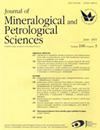Chemical and lithium isotope characteristics of murakamiite and Li–rich pectolite from Iwagi Islet, Southwest Japan
IF 1
4区 地球科学
Q4 MINERALOGY
引用次数: 6
Abstract
We report in situ major and trace element and Li isotope analyses of murakamiite and Li – rich pectolite in an albitite and whole – rock analyses of the albitite and host granite from Iwagi Islet, SW Japan. The albitite forms small bodies that are several tens of centimeters to tens of meters in size, disseminated in a host granite of Late Cretaceous age. The studied murakamiite – bearing albitite contains albite, sugilite, aegirine – augite, quartz, murakamiite – Li – rich pectolite, microcline, katayamalite, and accessory minerals. It shows conspicuous strain – induced textures. The murakamiite and Li – rich pectolite form a solid solution with Li × 100/(Li + Na) atomic ratios ranging from 44.2 to 60.1, and the Na line pro fi les show a zoning structure in which Na decreases from core to rim. Major and trace element compositions of murakamiite – pectolite normalized to that of albitite in-dicate the enrichments of some elements, particularly in Mn, Ca, Li, Sr, and REEs, roughly on the same order of magnitude (~ 10 times). The albitite – normalized element concentrations vary systematically with ionic radius of the element; the normalized concentrations of cations with the same valence roughly form a simple convex parabolic curve when plot against the ionic radius. This indicates that the element partitioning of murakamiite and pectolite during metasomatism to form albitite took place under a strong control of crystal structure, quasi – equilibrated with metasomatic fl uids and coexisting minerals. The δ 7 Li values of murakamiite and Li – rich pectolite show a wide range from − 9.1 to +0.4 ‰ (average − 2.9 ‰ ), and no obvious correlation with Li contents was observed. These δ 7 Li values should have resulted from hydrothermal fl uid – rock interactions at the temperatures of 300 – 600 °C. The very low δ 7 Li values down to − 9.1 ‰ may have originated from intra – crystalline Li isotope di ff usion, or involvement of deep – seated, Li – Na – enriched subduction – zone fl uids with low δ 7 Li values. ,日本西南部岩城岛村上岩和富锂果胶岩的化学和锂同位素特征
我们报道了日本西南部岩城岛钠长岩中村神岩和富锂果胶岩的原位主元素、微量元素和锂同位素分析,以及钠长岩和寄主花岗岩的全岩分析。钠长石形成几十厘米到几十米大小的小型岩体,散布在白垩纪晚期的花岗岩中。所研究的含云纹岩的钠长石包含钠长石、苏铁榴石、赤铁矿-辉石、石英、富云纹岩-富锂果胶岩、微斜长石、方钠石和副矿物。它显示出明显的应变诱导纹理。Murakamite和富含Li的pectolite形成了Li×100/(Li+Na)原子比为44.2~60.1的固溶体,Na线颗粒显示出Na从核心到边缘减少的分区结构。与钠长石标准化后的村安岩-镜铁矿的主元素和微量元素组成表明,一些元素的富集程度大致相同(约10倍),特别是Mn、Ca、Li、Sr和REE。钠长石-归一化元素浓度随元素离子半径的变化而系统变化;具有相同化合价的阳离子的归一化浓度在相对于离子半径绘制时大致形成简单的凸抛物线。这表明,在交代形成钠长石的过程中,Murakamite和pectolite的元素分配是在晶体结构的强烈控制下进行的,与交代流体和共存矿物准平衡。村安岩和富锂果胶岩的δ7Li值范围较宽,为−9.1~+0.4‰(平均−2.9‰),与Li含量无明显相关性。这些δ7 Li值应该是300–600°C温度下热液-流体-岩石相互作用的结果。低至−9.1‰的非常低的δ7 Li值可能源于晶体内Li同位素的扩散,或参与了低δ7 Li的深层富集Li的俯冲带流动,
本文章由计算机程序翻译,如有差异,请以英文原文为准。
求助全文
约1分钟内获得全文
求助全文
来源期刊
CiteScore
1.80
自引率
14.30%
发文量
5
审稿时长
>12 weeks
期刊介绍:
The Journal of Mineralogical and Petrological Sciences (JMPS) publishes original articles, reviews and letters in the fields of mineralogy, petrology, economic geology, geochemistry, planetary materials science, and related scientific fields. As an international journal, we aim to provide worldwide diffusion for the results of research in Japan, as well as to serve as a medium with high impact factor for the global scientific communication
Given the remarkable rate at which publications have been expanding to include several fields, including planetary and earth sciences, materials science, and instrumental analysis technology, the journal aims to encourage and develop a variety of such new interdisciplinary scientific fields, to encourage the wide scope of such new fields to bloom in the future, and to contribute to the rapidly growing international scientific community.
To cope with this emerging scientific environment, in April 2000 the journal''s two parent societies, MSJ* (The Mineralogical Society of Japan) and JAMPEG* (The Japanese Association of Mineralogists, Petrologists and Economic Geologists), combined their respective journals (the Mineralogical Journal and the Journal of Mineralogy, Petrology and Economic Geology). The result of this merger was the Journal of Mineralogical and Petrological Sciences, which has a greatly expanded and enriched scope compared to its predecessors.

 求助内容:
求助内容: 应助结果提醒方式:
应助结果提醒方式:


